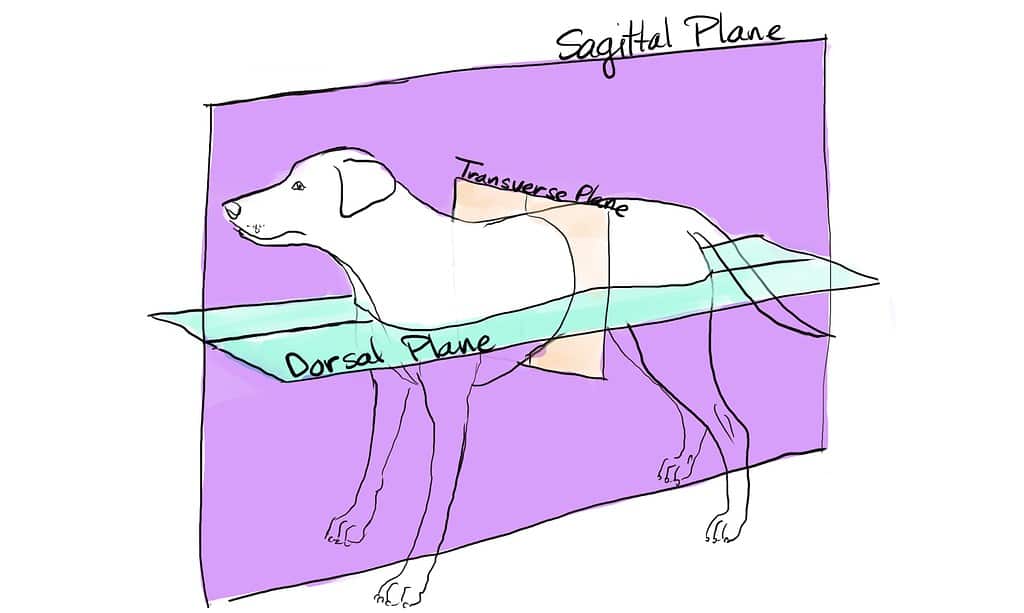Although you may be comfortable using scientific names along with common names for plants and animals, you may not have considered anatomical planes and cavities — those have scientific names too. You may have heard of dorsal and ventral, but what do they mean?
Dorsal and Ventral Cavities: What Are They?
The simplest way to explain dorsal or ventral is that the dorsal side is on or towards the back and the ventral is on or towards the front. So, instead of saying “back” and “front” we say dorsal and ventral.
Biologists and other scientists divide the body into smaller sections using planes. Then, they use either Latin or Greek-based words to refer to them, in a similar fashion as scientific names for plants and animals.
We divide an organism’s body into its dorsal and ventral cavities by way of the frontal plane. This plane divides the torso into two pieces: the top half and bottom half, giving you the dorsal and ventral cavities.
When you describe the dorsal cavity of an organism, you are describing the upper side or the back. It includes those parts of the body towards the top — the spinal column, the top of a leaf, and the dorsal fin are all on the dorsal side of the organism, whether it is a plant or an animal.
In contrast, the ventral side or cavity refers to the belly or underside. In many animals and some plants, the ventral side is softer and more vulnerable — which is why animals curl up into a ball or lay belly down to try and protect their vital organs.
The Importance of Directional Terms in Anatomy
There are times when it’s very important, such as describing an injury or physical feature. Biologists and other scientists like using directional terms. They make discussing different physical features and locations on the body more accurate — and communication more effective.
So, while might not be earth-shatteringly important, it may be simpler to say dorsal and ventral instead of any of several different words in English. For example, back, front, top, bottom, underside, and upper side are all words that could mean the same thing in anatomy. Then, if you look at other languages, it gets even more complicated. Now, you have dozens of different words that mean essentially the same thing. Yet, dorsal and ventral can cross over the language barrier and be used almost universally by different scientists.
Often, whether you use anatomical planes and directional terms in your daily life is a decision you can make for yourself. However, knowing them can make reading or listening to anything even a little scientific much easier.
Differences in Anatomical Structures and Functions in the Dorsal and Ventral Sides
Dividing plants and animals via the frontal plane into dorsal and ventral sides means there are different sets of organs and structures on or in each — which often vary from one species to the next.
The dorsal side contains the spine and brain cavity. It can also include anatomical features like:
- Dorsal fins
- External shells and carapaces
- Crests and spikes
- Eyes and nostrils
- Fur and hair
- Spines
In contrast, the ventral side holds the vital organs. The ventral cavity also contains:
- Reproductive organs
- Mammary glands
- Lower half of a turtle’s carapace
- Usually the limbs

Scientists divide the body into several cavities by using different anatomical planes.
©A-Z-Animals.com/GBNelson
Clinical and Scientific Relevance of Anatomical Planes
The most important benefit to using directional terms like dorsal and ventral is that, by agreeing on a set of terms to use for body parts, locations, and directions, scientists in different disciplines can communicate clearly and quickly. Directional terms not only tell you where a body part is but also where it is in relation to other body parts.
So, a biologist can say, “There is a 3-inch scar located on the dorsal side of the dolphin’s caudal fin.” Every biologist would understand they are looking for a 3-inch-long scar on the top side of that animal’s tail fin. This is just one example of how directional terms help scientists communicate clearly.
Where to Learn About Anatomical Planes
Learning about anatomical planes and directional terms is not very hard, but takes a little time and study. However, resources are easily found! A quick internet search brought up a fantastic resource online at Libretexts.org. This one gives you a full explanation of all the anatomical planes and cavities, including everything that you might find inside them. There are many more available, and any college-level anatomy course covers the topic in-depth, with many species.
Thank you for reading! Have some feedback for us? Contact the AZ Animals editorial team.








